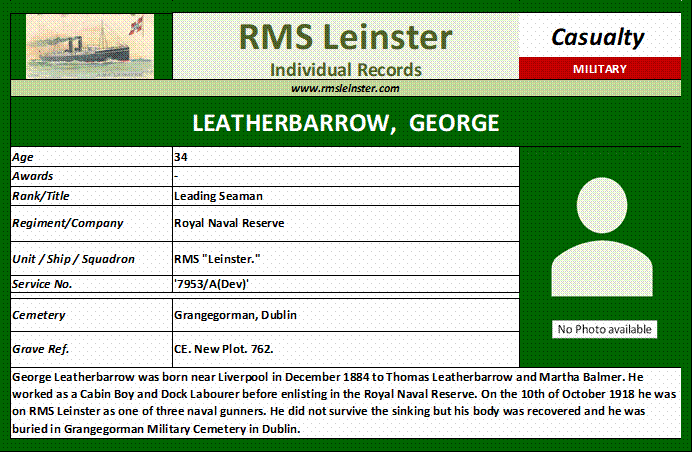 |
 |
 |
||||||
People on board
LEATHERBARROW, George George Leatherland was born in Walton, near Liverpool, on the 23rd of December 1884 to Thomas Leatherland and Martha Balmer. He was the youngest of their seven children, five of whom were alive in 1911. Thomas and Martha, who married in 1870, were living in Walton-on-the Hill with her widowed mother and younger siblings in 1871 but they had their own household in Walton by 1881. Thomas Leatherland was a Carter / General Labourer, while in the 1891 census Martha and her mother, who was then living with them, both gave their occupation as Laundress. Thomas died in 1893 at the age of forty-three and in 1901 only two sons, William and Robert, were living with Martha. George, aged sixteen, was found in that census working as a Cabin Boy on a steam tug, the Conquerer, in Bootle on the Mersey docks. George had given up the seafaring life by 1911 and was at home in Walton with his mother and brother Robert, giving his occupation as Dock Labourer. However at some stage once war was declared he enlisted in the Royal Naval Reserve. In October 1918 he was on board RMS Leinster as a Naval Gunner with the status of Leading Seaman. At this time merchant ships were beginning to have guns on board to counter the submarine threat, though this policy proved of little use. The City of Dublin Steam Packet Co’s Crew Agreement List for 1918 show that there were twelve gunners on the Kingstown to Holyhead route and it appears that there were three on board the Leinster on the 10th of October. George Leatherbarrow did not survive the sinking but his body was recovered and he was buried in Grangegorman Military Cemetery. His mother Martha had died in 1915 so his next-of-kin was his brother William who was living with his family in Olney Street in Walton. George is remembered on the Merseyside Roll of Honour.
|
||
